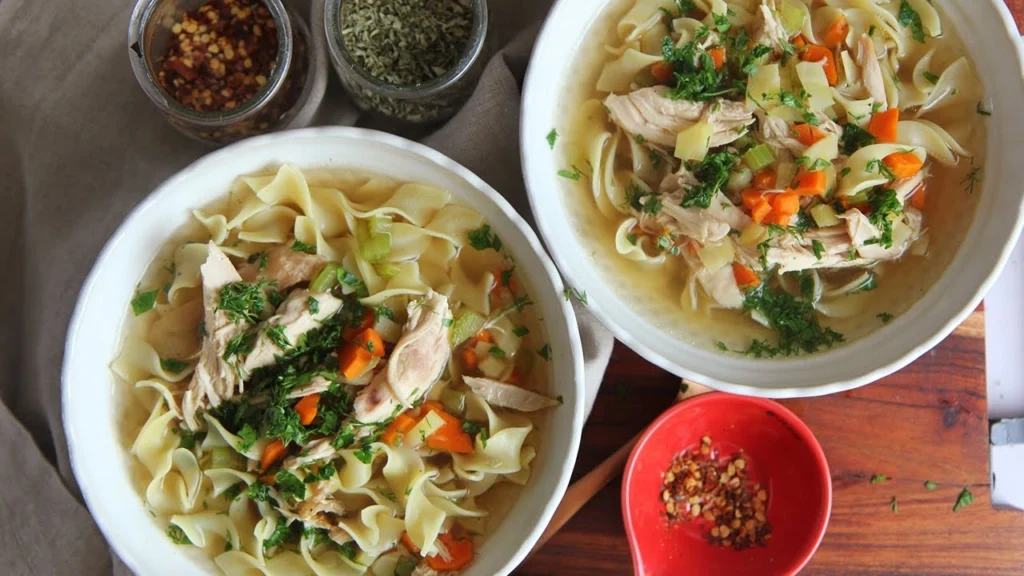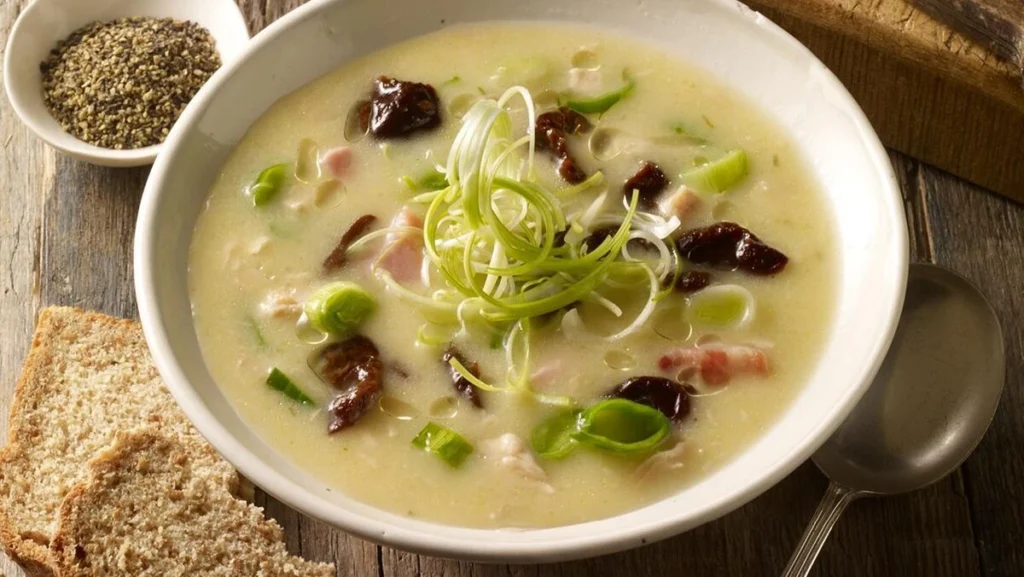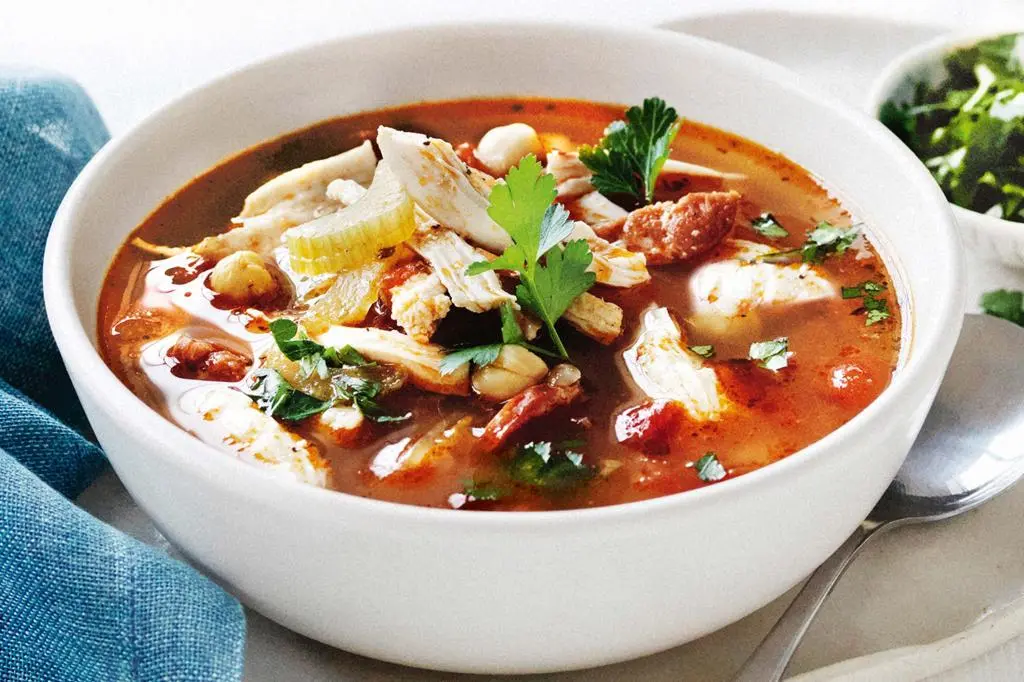Cocky Leekie Soup Recipe | Step-by-Step Guide

We should just be honest—the name cocky leekie is kind of silly, at least at first, right? But this soup is anything but childish. This is a robust, traditional Scottish dish that has warmed the bellies of many for centuries. Yes, we are talking about chicken, cooked with sweet leeks, rice, and then prunes. Yep, prunes. It sounds weird, and I get that, but it does kind of work. This is chicken soup’s quirky cousin that nobody talks about enough. This recipe gets back to basics, simple, cozy, and delicious. Whether you are preparing for a bitterly cold night inside or you are simply interested in what grandmothers in Scotland have been making for centuries, this step-by-step recipe will have you covered. If you’re into classic comfort soups, you might also love this creamy tomato soup—another simple bowl of joy.
What Even Is Cocky Leekie Soup?
Right, let’s clear this up. Cocky leekie soup is basically the Scottish version of chicken and leek soup, but with a twist (hello, prunes). It’s been around since the 1500s or something ridiculous like that. Back then, it was made with an old rooster, hence the “cock,” and loads of leeks boiled into oblivion.
These days, we don’t tend to have roosters just kicking around, so we use regular chicken—usually on the bone for that proper rich broth—and the leeks are still the star. The prunes? They’re traditional too, though I almost skipped them. Glad I didn’t.
Here’s What You Actually Need
I didn’t want to overcomplicate things, so I kept it pretty classic. This is what I used:
- A pack of bone-in chicken thighs (I think it was about 1.5 lbs?)
- 3 fat leeks
- A handful of prunes (don’t worry, they melt in)
- About 1/3 cup of rice (though barley works too—more on that later)
- Chicken stock (boxed stuff is fine, but homemade is obviously better if you have it)
Salt, pepper, parsley, that’s it.
Whole Chicken or Just Pieces?
I thought about going all in with a whole bird, but honestly, I was tired and didn’t feel like dealing with bones everywhere. So I went with bone-in thighs. They’re cheap, they’ve got great flavor, and they hold up better in soup than breast meat, which can get dry and sad.
If you do want to use a whole chicken, though, go for it. You’ll get a richer broth and more leftovers, obviously. Just be prepared to wrestle it apart once it’s cooked.

Cleaning Leeks Is a Whole Thing
Here’s what nobody tells you when you start cooking with leeks: they are filthy. Like, dirt-between-every-layer filthy.
So here’s what I did: I chopped off the dark green tops (they’re super tough—save them for stock if you’re being frugal), sliced the white/light green parts lengthwise, and fanned them out under running water. Took forever, but worth it. Once they were squeaky clean, I sliced them into thin half-moons.
Pro tip: don’t skip this step. Gritty soup is not the vibe.
The Great Prune Debate
Okay, this is the weird part. Prunes in soup? Really?
I was suspicious too. I almost didn’t add them. But then I thought—if people have been doing this for hundreds of years, maybe they knew what they were doing. So I tossed a handful in near the end of cooking and… wow.
They don’t make the soup sweet or anything. They just kind of melt into the background and add this rich, deep flavor that makes everything else taste better. Would I add more next time? Maybe. But I wouldn’t leave them out now.
Rice vs. Barley: The Showdown
Look, I love barley. It’s got that nutty chewiness that feels super old-school. But I went with rice this time because I didn’t want to wait 45 minutes for the barley to soften.
If you’ve got time, use pearl barley. If not, white rice totally works. Just don’t overdo it, or you’ll end up in a porridge situation. I used about 1/3 cup, and that was perfect. Gave the broth a little body without taking over the whole show.
Let’s Cook This Thing – Step-by-Step
Alright, here’s how it went down in my kitchen:
- Threw the chicken into a big pot with the stock. Brought it to a simmer, skimmed the weird foamy stuff off the top (gross but important), and let it go for about 45 minutes.
- Pulled the chicken out, let it cool enough to handle, and shredded it. Tossed the bones.
- While the chicken cooled, I chucked the sliced leeks into the broth and let them soften up—maybe 10 minutes?
- Then I added the rice and the prunes. Let that simmer for another 20-ish minutes until the rice is cooked through and the prunes have mostly disappeared.
- Tossed the chicken back in, added salt and pepper to taste (I went heavy on the pepper, no regrets), and let it bubble gently for another few minutes.
- Finished it with a handful of chopped parsley and served it with crusty bread. Heaven.
I Tried It in a Slow Cooker Too
A week later, I tried doing this in the slow cooker because I had a day of errands and zero energy to stand at the stove.
I threw everything in except the rice and prunes, let it go on low for about 6 hours, then added the rice and prunes in the last hour. Still good. Not as rich as the stovetop version (no skimming means some weird scum floats around), but honestly? Not bad for a lazy day.
You could also do it in an Instant Pot. Chicken for 25 minutes, quick release, add rice and prunes, cook another 8 minutes. Boom.

How to Serve It
You don’t really need anything with this soup—it’s a meal on its own. But I served it with some crusty sourdough and a lot of butter because carbs are life.
Other ideas:
- A little swirl of cream on top (fancy)
- Chopped chives or parsley
- Freshly cracked black pepper, heavy on the elbow twist
Or just eat it straight out of the pot while standing over the stove. No judgment.
Also, if you’re looking for something heartier to serve alongside or afterward, this ragu spaghetti sauce recipe pairs beautifully for a full-on comfort food day.
Leftovers Are Even Better
This soup keeps really well, maybe even gets better after a day or two.
Fridge: Keep it in the fridge for about 4 days. When you reheat it, you might need to add some water to it.
Freezer: Totally freezer-friendly. I froze two batches, and they reheated like a dream.
Microwave or stovetop: Both work. Just go low and slow so you don’t dry out the chicken.
Final Thoughts
Cocky leekie soup sounds strange. It looks easy. And yet here we are, with my spoon sinking into one of the coziest, most comforting bowls of food I’ve had in a long time. It tastes like something someone made for you when you were ill or sad or coming in from being drizzled on.
It’s not fancy. It’s not cool. But it is the type of food that makes you feel cared for. And we could all use a little more care.
FAQs
Do I have to use prunes?
Nope. But you should try it at least once. Trust me.
Can I use boneless chicken?
You can, but it won’t have that deep, rich flavor. Bones make broth better.
What’s the best rice to use?
Just plain white rice. Nothing fancy. Jasmine worked fine for me.
Is this gluten-free?
If you use rice, yep. Just double-check your stock.
Can I make it vegetarian?
Honestly, not really. You could try mushrooms and veggie broth, but it’d be a different dish altogether.
